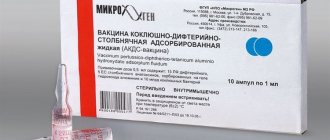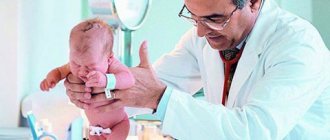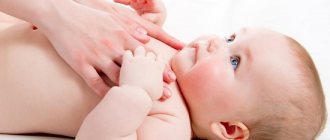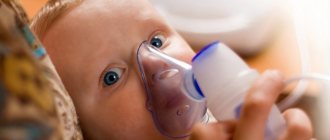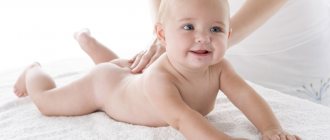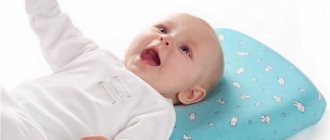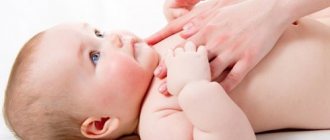For children under one year old, gymnastics and therapeutic massage are mandatory components of development. The first year of life is the most important; the child gets to know his mother and father, the world around him, learns to communicate, and gets to know the world in its manifestations. Parents often face the question of what to do for the baby’s development during this period, and what procedures are necessary. Does the baby need a therapeutic massage or does he need gymnastics, how many sessions are required.
Massage for children from 1.5 to 3 months
It is recommended to start massage and gymnastics classes at 1.5-2 months of age. The leading massage technique at this age is stroking.
Stroking foot massage (Fig. 1). Place the child on his back. Stand at his feet. Lightly holding the child's leg by the foot with your right hand, stroke the palm of the other hand in the direction from the foot to the groin on the outside and back of the leg. The massage of the left leg is performed in the same way, but with the right hand.
Stroking hand massage (Fig. 2). Make massage movements from hand to shoulder. When massaging your right hand, hold the child’s hand with your left hand so that he wraps his fingers around your thumb. Using the palm of your right hand, stroke the inner and outer surfaces of the forearm and shoulder. When massaging a child's left hand, hold his hand with your right hand and massage with your left.
Abdominal massage (Fig. 3) is performed in a circular motion with the palms of the hands in a clockwise direction. These movements help strengthen the abdominal muscles, improve bowel function and relieve gases.
In this case, you should not press on the area of the right hypochondrium - the liver is located there. In addition to circular stroking, a massage is performed on the rectus and oblique abdominal muscles: to stroke the rectus muscles, the right hand begins to move from top to bottom from the hypochondrium to the pubis, and the left hand moves from the pubis upward. To stroke the oblique muscles, the palms of both hands are placed above and behind the costal edge and stroking is carried out with a grasping movement towards the midline and down to the junction of the hands above the pubis.
Foot massage (Fig. 4). Having placed the child on his back with his feet facing him, they take the child’s leg by the shin with one hand and stroke the foot from the toes to the heel and back with the back of the fingers of the other hand.
Back massage (Fig. 5) is carried out with the child positioned on his stomach. A stroking massage is carried out with the palmar surface of both hands from the neck on both sides of the spine to the buttocks and from the buttocks to the head.
Each massage movement is performed 6-8 times. The total duration of classes is 8 minutes. Along with the massage, simple exercises of the gymnastics complex are performed, such as laying on the stomach, reflex crawling, reflex extension of the back.
How often should I use it?
The regularity and timing of the procedure depend on the age of the child and individual indications. If there are no negative reactions and special recommendations from the doctor, then sessions can be performed daily.
The first sessions should last no more than 5 minutes, and by 6 months the massage time along with gymnastic exercises reaches 20-25 minutes. The session begins an hour after a meal and 30 minutes before a meal.
Children's foot massage is a means of preventing the occurrence of many diseases of the musculoskeletal system, nervous system and digestion. Before giving a child a foot massage, you should consult a pediatrician to identify contraindications and possible restrictions. It must be remembered that children's bones are fragile, and careless movement can lead to injury. You can perform a massage yourself every day if there are no negative reactions. The main movements are in a circle, in straight lines, zigzag and wavy. The procedure should be performed with increasing intensity and always end with soft stroking movements.
Massage for children from 3 to 4 months
Massage techniques for children of this age include stroking, rubbing and kneading.
Foot massage. Ring-shaped rubbing of the shins or kneading is recommended. When performing ring-shaped rubbing (Fig. 6), one hand clasps the outer surface of the leg, the other - the inner surface and performs rotational movements from the foot to the knee; then massage the outer surface of the thigh from the hip joint. This massage strengthens the leg muscles. It is also performed 4-6 times. In this case, the child’s leg should be slightly bent at the joints for maximum muscle relaxation.
Hand massage is carried out by stroking or light rubbing (Fig. 7). The child lies on his back. Lightly holding his right hand with his left hand, make light rubbing movements from the hand to the shoulder with the right. The exercise is repeated 4-6 times. The left hand is also massaged.
Kneading (Fig. 8) is carried out as follows: the child’s right leg rests freely on the mother’s right palm, which holds the leg in the area of the lower third of the lower leg. Using three fingers of the left hand, knead the muscles of the front and outer surface of the lower leg and thigh from the foot upward. The left leg is massaged with the right hand. The technique is repeated 4-6 times.
Abdominal massage (Fig. 9) is performed by stroking and rubbing. Make light rubbing movements along the oblique muscles of the abdomen, starting from the side walls of the abdomen and then moving to the front so that the fingers of both hands are connected on the pubis. This massage is performed 6-8 times. Finish with stroking. Abdominal massage strengthens the abdominal muscles and promotes the release of gases.
Back massage (Fig. 10) - kneading. The child lies on his stomach. Make circular forward movements with your palms, vigorously stretching the back muscles from the lower back to the neck. Should be repeated 5-6 times. In addition, when massaging your back, you can use the technique of sawing with the ulnar edges of your palms.
Massage of the buttocks (Fig. 11) - patting. The back surface of the fingers of both hands is lightly patted on the buttocks. Repeat 8-10 times, changing hands all the time.
Foot massage - stroking (see Fig. 4). The child lies on his back with his feet towards the front edge of the table. Holding the child's elevated foot with your index fingers, use your thumbs to stroke the back of the foot from the toes to the ankle joint and around the base of this joint. The exercise is performed 4-6 times in one direction and the other. This massage strengthens the muscles and ligaments of the foot.
Foot massage - rubbing (Fig. 12) is performed by grasping the child’s foot with the index and middle fingers of the right hand, using circular movements of the thumb located across the foot. The exercise prevents the development of flat feet. This technique is carried out 6-8 times.
Along with the massage, the following physical exercises are performed with a child of this age: bending the legs, crossing and raising the arms, a reflex turn from back to stomach, arching the back, moving to a sitting position (with help).
The duration of the entire complex is 8 minutes.
Useful massage for baby's first steps
Some parents, closer to the age of one year, begin to worry why the child has not yet walked on his own. My friends’ babies started running after 9-10 months. They begin to massage the child to start walking and expect instant results. Pediatricians and orthopedists are tired of repeating that each baby has its own development program. If the baby took his first steps several months after his first birthday and there is no developmental delay, this is considered the norm.
However, doctors advise visiting a massage parlor or doing a massage yourself at home. It will help strengthen little legs and increase muscle tone.
Massage for children from 4 to 6 months
At this age, the child tries to lift his body from a supine position. For stimulation, simple active exercises and massage are recommended.
Hand massage - stroking and light rubbing 8-10 times (see Fig. 1 and 6).
Abdominal massage - stroking, rubbing 8-10 times each time (see Fig. 3).
Foot massage (see Fig. 2 and 7) - stroking, rubbing, ring-shaped rubbing of the legs and thighs. 6-8 times each dose. Rubbing is performed with the palms of both hands. When massaging the left leg, the right palm moves along the outer surface, the left palm moves along the back surface of the leg of the thigh, when massaging the right leg, the outer surface is massaged with the left palm, and the back with the right palm. Rubbing is done in a circular motion with enough pressure on the massaged area to lightly displace the skin. The knee joint area is not massaged. After rubbing, a general stroking massage of the legs is performed.
Back massage (see Fig. 5 and 10) - stroking 8-10 times, rubbing 8-10 times, kneading 6-8 times.
In some cases, a vibration massage of the back is performed - patting. It is performed with the back of the bent fingers of a relaxed hand simultaneously with both hands over the entire surface of the back, except for the kidney area. The average duration of this type of massage is up to 1 minute.
Chest massage (Fig. 13) - stroking the palmar surface of the hands in a fan-shape along the pectoral muscles towards the armpits 4-6 times. Spiral movements between the ribs with slightly bent fingers of both hands along the front surface of the chest - 4-5 times. Vibration of the chest muscles is carried out with both hands - they clasp the child on both sides so that the thumbs are in front. Then make rhythmic movements with your hands up and down along the chest up to 12 times. The chest massage ends with stroking, which is performed 5-6 times. All chest massage techniques strengthen the respiratory muscles and promote deepening of breathing.
Foot massage (see Fig. 4 and 12) - stroking 8-10 times, rubbing the toes 6-8 times, rubbing the foot 6-8 times.
The complex also includes: crossing the arms on the chest and moving them to the sides, extension and flexion of the spine and legs, stomping (passive), turning from the back to the stomach, sitting down, spreading the hips wide and other exercises.
The total duration of the lesson is 10 minutes.
Massage for children from 6 to 9 months
At this age, the child’s movements are enriched every day. Sitting and standing postures are mastered. There is a transition to a vertical position. In physical education classes, active gymnastic exercises are more widely used, which are performed by the child himself. The mother or other adult working with the baby only directs the movements with their own hands. The complex of physical exercises also includes massage.
Abdominal massage (see Fig. 3) - stroking, rubbing. 8-10 times each time.
Foot massage (see Fig. 4 and 12) - stroking 8-10 times, rubbing the toes 6-8 times, rubbing the foot itself 8-10 times.
Chest massage (see Fig. 13) - stroking, rubbing, vibration. 6-8 times each time. A stroking massage of the back and abdomen is carried out as a means of relaxation between exercises.
Duration of classes is 12-15 minutes.
Recommendations
- If the child behaves restlessly when touching the feet, the child does not like the situation, we can safely say that the exercises are being done incorrectly. It is impossible to continue when the child is in a nervous state. Calm the child, then continue.
- During a foot massage, it is useful to talk with the baby, sing songs, read poetry, and turn on a pleasant melody.
- For tactile work with a child’s feet, specialists do not recommend using products or liquids. Various creams and other substances will not allow the mother to fully feel contact with the baby’s body and will reduce the benefits of treatment. An inexperienced person can make mistakes in pressing with force, speed and stopping techniques. Any massage cream or other substance clogs the pores, causing overheating.
- The room in which physical exercises to prevent foot diseases are expected must be ventilated.
- If you are working with your child during the cold season, it is useful to choose a warm place.
- Foot massage for infants is required exclusively with the fingers and hand.
- To check the adequacy of force and pressure, the massage therapist must test the techniques on himself.
